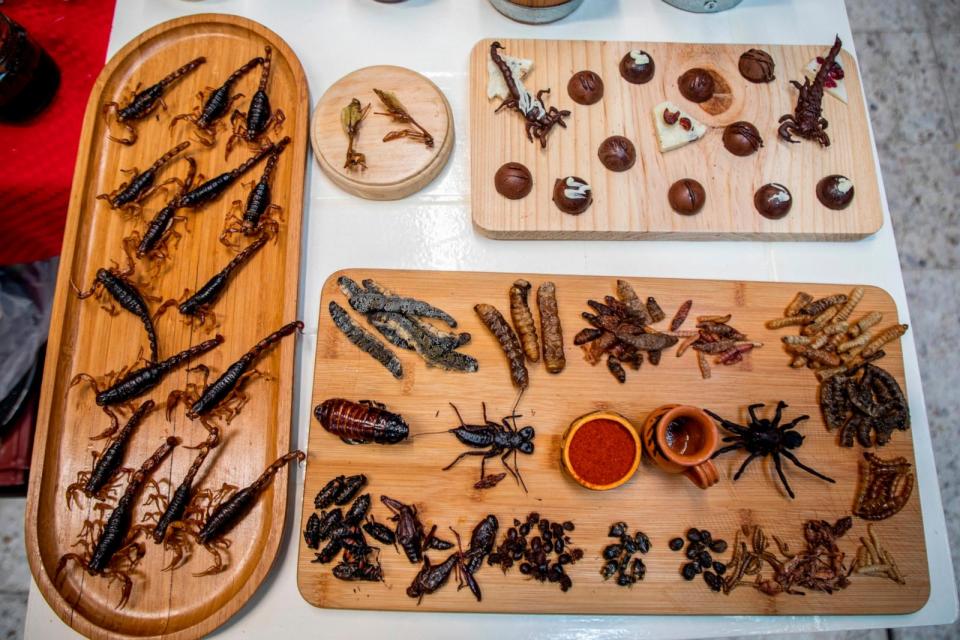Consuming insects is common in many global cuisines – from roasted locusts in Mexico to fried mealworms in Thailand – many people have found room for insects on the plate. But will Americans ever see insect eating as more than a daring novelty?
Experts say insects are a climate-friendly and nutrient-rich alternative to typical animal proteins, but when it comes to Western cultures, the ‘ick’ factor gets in the way of an insect-inclusive diet.
“Because of our heavy European cultural influence, most Americans shy away from the idea of eating insects,” David Shetlar, Ph.D., professor of entomology at Ohio State University, told ABC News.

According to Shetlar, Native Americans incorporated insects into their diets to reflect the season, such as eating crickets during their periodic outbreaks and foraging for locusts in late summer.
Nutritionally, crickets contain 21.4 grams of crude protein per 100 grams, according to a 2023 study “Edible and Medicinal Progress of Cryptotympana atrata (Fabricius) in China.”
MORE: After Eclipse: Nature’s Next Big Show: Double Rise of Cicadas
The study found that crickets contain about 1.6% more protein than that found in pork and eggs. In contrast, the fat content of crickets – 2.6 grams per 100 grams – is much less than that of pork and beef.


According to the National Institute of Health (NIH), there are 2,100 species of insects that are consumed as food in more than 110 countries.
“There are several initiatives worldwide to grow insects for food,” Shetlar said, noting that Asian as well as African and Polynesian cultures have regularly included insects in their diets.
MORE: Insects creep onto menus in latest food trend
When concluding which animals are “gross” or “good” to eat, researchers say it comes down to conditioning and familiarity, which can be difficult to reverse.


Shetlar argued that farmed shrimp, crustaceans that belong to the same phylum or taxonomy as insects, exemplify this nutritional perspective.
The US Food & Drug Administration reports that if you are allergic to shellfish, eating insects such as crickets because of the relationship can cause a similar allergic reaction.
“We think that people in Western societies are reluctant to eat insects because it is not the norm to do so, and people are disgusted by the idea,” Dr. Maxine Sharps, a social and health psychologist at De Montfort University, told ABC News. .
“As insects become more common in the food system and people become more familiar with them, they may be more willing to try them and include them in their diets,” Sharps said.


In a recent study, Sharps and fellow researchers surveyed 603 adults in Britain and found that only 13% of respondents said they would be willing to regularly consume insects, compared to 47% who responded that they would not, and 40 % who responded ‘maybe’ or ‘not sure’ to the question.
Crickets and mealworms are the most common types of insects eaten around the world, according to Sharps, who claims that they are not only safe to consume but also a source of protein and nutrients.
Reflecting its namesake, mealworms are gaining attention worldwide as a protein source for food purposes, according to the NIH.
Fresh yellow mealworm larvae contain about 15% fat and 20% protein, while freeze-dried yellow mealworm larvae contain about 33% fat and 51% crude protein, according to the NIH.


Looking at the intersection of typical Western diets and the environment, experts say the role livestock farming plays in global warming is a reason for change.
“Traditional farming systems place enormous pressure on the environment, while insect farming uses less land and water and produces lower greenhouse gas emissions than farming animals,” Sharps said.
According to the Food and Agriculture Organization of the United Nations, raising farm animals – cows, pigs and chickens – for human consumption is responsible for 14.5% of global greenhouse gas emissions.
MORE: Sustainable eating is one of the easiest ways to fight climate change, experts say
To put that into perspective, according to the UN, the ecological footprint of livestock farming is the second largest source of emissions, after electricity and heat production, and higher than all transport-related emissions.
The agency notes that livestock farming is one of the leading causes of deforestation, biodiversity loss and water pollution.
Dr. Lauren McGale, an Edge Hill University researcher behind the recent study with Dr. Sharps, told ABC News that eating insects, using plant-based products or trying lab-grown meat alternatives “could contribute to a more sustainable food system overall.”
“This is unlikely to be a silver bullet for sustainability. We know that people are not particularly willing to consume insects,” McGale acknowledged, adding: “However, it could still be a potential option for those who are willing.”
Should people eat insects instead of meat? Experts explain the benefits of bugs originally appearing on abcnews.go.com